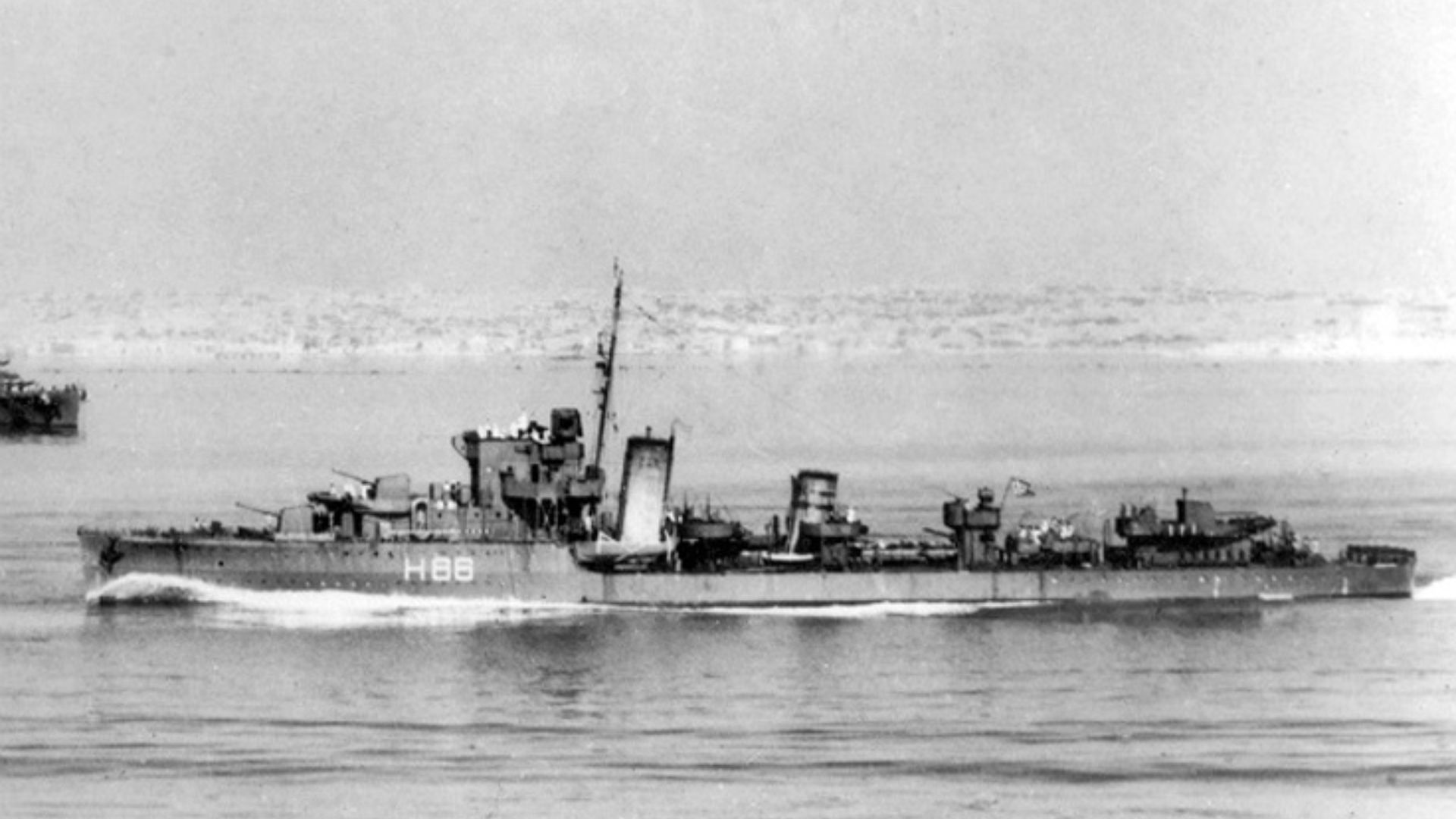
The Vasilissa Olga (D15/H86) (Βασίλισσα Όλγα) was a destroyer of the Greek navy, which was used in World War II and was sunk in 1943. The destroyer, named after the Greek Queen Olga, was a member of the group consisting of a total of two units of Vasilefs Georgios class.
The construction contract for both vessels was awarded to the British shipyard Yarrow Shipbuilders in Glasgow, Scotland; the ships represented a slightly modified and enlarged British-type G-Class dar. The keel was laid Vasilissa Olga was held on 1 Held in February 1937. After the launch on 2nd Took place on 4 June 1938 February 1939 the commissioning. The first commander of the destroyer was Captain Michalis Zarokostas.
Features And Modifications
Although built in a British shipyard, the Greek Navy that the new destroyer, not with British 12-inch guns but with the latest German 12,7 cm gun C/34 (L/45), which also the destroyers of the German class in 1934 used, should be equipped. In addition, the Vasilissa Olga four 3.7-cm Flak C/30 received (L/83), which also came from German production.
After the German invasion of Greece in 1941, the destroyer escaped to Alexandria and joined the Royal Navy. There, Vasilissa Olga received the new temporary identifier H86. As part of extensive alterations and modifications in the winter of 1941/42, including all came 3.7cm Flak, a torpedo tube set, and the machine guns from aboard the destroyer according to the needs of the British Navy in terms of submarine hunting and convoy security service upgraded.
The destroyer got a (British) 7.62-inch gun and six light 20-mm Oerlikon guns n To improve the anti-submarine capabilities, the number of hydrogen bomb throwers was six, and the number of entrained water bombs increased from 17 to 54. When performed after testing the shipyard stay, Vasilissa Olga reached a top speed of 36.1 knots.
Missions In World War II
1940/41 - Attack of Italy and the Balkans campaign
After a relatively uneventful period of service, 1939-1940 began for the Greek Navy during the Second World War; the end of October 1940, the Italian attack on Greece. The Vasilissa Olga made this leading assurance service in the Cyclades to prevent incursions of Italian submarines.
In January 1941, the destroyer conducted a nocturnal foray into the Strait of Otranto to attack any Italian supply transports, but no success was achieved. Given the justified fears of German intervention in the Balkans, the Vasilissa Olga transported, in February 1941, the gold reserve in the Greek state bank for safety from Athens to Crete.
Starting in April and especially in May 1941, in the context of the attack of the German army on Greece, the Greek fleet suffered from German air raids heavy losses, so the remaining ships, the armored cruiser Georgios Averof, three destroyers (including the Vasilissa Olga) and five U - boats, were transferred in May 1941 to Alexandria, there came in the same month with Lieutenant Commander George Blessas, a new commander on board.
The ships of the Hellenic Navy were built in the following months in the Royal Navy. Alexandria from the Vasilissa Olga went through the Suez Canal in October 1941 and moved in order to a planned upgrade to Calcutta, where she arrived in November 1941.
1942 Replenishment Rides And Submarine Hunting In The Eastern Mediterranean
After an extended stay in Calcutta and extensive shipyard tags, Vasilissa Olga returned in February 1942. She took back to the Mediterranean in the following months, along with British destroyers, to the supply of the besieged by the German Afrika KorpsTobruk part.
The Vasilissa Olga rescued 26 March 1942 from Sidi Barrani 20 survivors of the British naval tanker RFA Slavol (2,623 GRT), which had previously been sunk by a German submarine. On 10 June 1942, also hid the destroyer from 53 survivors from the torpedo of a submarine and severely damaged marine tanker RFA Brambleleaf (5,917 GRT).
In the second half of 1942, the Vasilissa Olga, in part with the British destroyer HMS Petard, on submarine-hunting operations in the eastern Mediterranean. Here, the two destroyers succeeded on 15 December 1942 south of Malta, the sinking of the Italian submarine R. Smg Uarsciek. The submarine was forced to surface by depth charge attacks and finally sunk by artillery fire, in which 18 Italian sailors were killed.
1943 Operations Against German And Italian Convoys
From the 8th January 1943, the Vasilissa Olga was used together with the British destroyer HMS Pakenham and HMS Nubian of Italy against current Tripoli Italian and German supply convoys. Here, the destroyer group succeeded on 19 January 1943, the sinking of the small German tanker Stromboli (475 GRT) off the Libyan coast.
After the capitulation of Axis forces in North Africa in May 1943, the approach of Vasilissa Olga against just off the coast of Sicily was taking place, coastal convoy traffic of the Axis powers.
Used in conjunction with the British destroyer HMS Jervis, and this also involved in the occupation of the island of Pantelleria by the Allies, the two destroyers were on the night of 2/3 June 1943 off Cape Spartivento a small Italian convoy, consisting of a small torpedo boat Castore (808 ts) and the two freighters Vragnizza (1,513 GRT) and Postumia (595 GRT), and surprise attack.
In the following battle, the torpedo boat, which is in defense of the steamboat but cleverly set in, is eventually sunk after nearly 90 minutes of fighting against about 3.15 clock artillery fire. However, the use of self-sacrificing Castore allowed two freighters to escape. Although both transporters on 3 June could still reach Messina, they were until the war ended; however, they were no longer taken for fire damage in the drive.
September 1943 - Operations In The Dodecanese
In September 1943, Vasilissa Olga was involved in the offensive against the British islands in the Dodecanese. Together and in overlapping use with British light cruisers and destroyers operated the ship in mid-September, especially against German supply convoys in the area.
Here, the Vasilissa Olga succeeded on 17 September, along with the British destroyers HMS Faulknor and HMS Eclipse, north of the island Astypalia the destruction of a running from Piraeus to Rhodes and consisting of two freighters and a backup ship small German convoy, the transporter Pluto (1156 GRT) and Paula (3,754 GRT) were while submerged, the backup car, the small submarine hunter UJ 2104 (400 ts), was so severely damaged that it had to sit in the coastal Astypaleas due. Later, the ship was abandoned.
In the third week of September, Vasilissa Olga was used to transport troops while on the ship, led 24-25. September, among other parts of the Long Range Desert Group, and supplies from Alexandria to Leros.
Demise Of The Vasilissa Olga
On 26 September 1943, during the Vasilissa Olga on the roads of Lakki, the port of Leros, was at anchor, 88 bombers became the destroyer in an attack by 25 German Ju faculty Squadron (LG) 1 to Lakki. It arrived within a few minutes, with two 250-kilogram bombs on the ship.
The first bomb struck the bridge, killing, among others, Lieutenant Commander Blessas. The second bomb hit amidships past the torpedo tube set and caused an explosion sequence that made the ship break through in the middle. Less than 15 minutes apart, broken Vasilissa Olga fell due, but the bug still towered nearly three hours out of the water. Of 162 crew members, 72, including the captain, died. In the same attack on Lakki, the British destroyer HMS Intrepid was so severely damaged that it had to be abandoned a day later.
